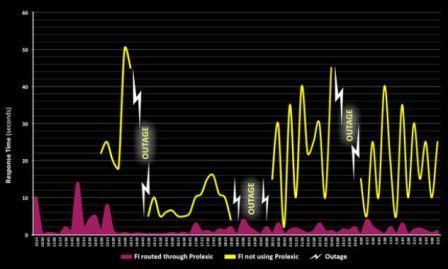Prolexic Latency Study Highlights Response Time Differences from DDoS Attacks against Two Banks
As daily headlines trumpet, not only are those with the intent to disrupt or destroy enterprise and government online capabilities busy, they are crafty as well. Indeed, the frequency and sophistication of cyber threats, particularly from outside perpetrators, are on the rise.
A favorite means of creating mayhem has been “Distributed Denial of Service” (DDoS) attacks. These are assaults where a high-traffic website is saturated with external communications requests with the goal of rendering it incapable of responding to legitimate traffic. While means vary the object is to overload a server and cause it to slow down or stop working.
There are various types of prevention out there, but as a recent comparative study by Prolexic, a leading provider of cloud-based DDoS protection services, proved that how your enterprise protects itself from DDoS attacks matters.
Comparing two bank attacks
This is nasty business and details tend not to make the stories behind the headlines. A study was done to look at response times – how long a page takes to load on a website –using the Compuware (News  - Alert) Gomez Application Performance Monitor, from multiple worldwide locations. It documented variations in load times during live DDoS attacks.
- Alert) Gomez Application Performance Monitor, from multiple worldwide locations. It documented variations in load times during live DDoS attacks.
As Prolexic notes in its discussion of the study, these were high-visibility attacks on two banks where the hackers were so bold they announced their intentions on hacker sites before the attacks were launched. Prolexic tracked the same DDoS attack against both banks simultaneously. One firm used Prolexic’s PLXrouted DDoS protection service while the other relied on another DDoS protection provider. And, as you might have surmised, the company using Prolexic had average website load times of two seconds or less, while the other experienced multiple site outages and lengthy delays in server response times.

Source (News - Alert): Prolexic
The Prolexic client suffered zero outages and pages typically loaded in a tolerable two seconds, even though these were significant DDoS attacks. In contrast, the firm that did not use Prolexic suffered three separate outages and website users had to endure page-loading times as high as 50 seconds in some cases, making the site unusable.
“Minimizing the impact of an attack is job number one for DDoS mitigation providers,” said Stuart Scholly, president at Prolexic. “Even if your website is under a severe attack, Prolexic can help ensure the user experience is maintained at acceptable levels.”
With the RSA (News - Alert) event about to kick off in San Francisco, DDoS is one of the most popular topics. An ounce of prevention really is worth a pound of cure which is why spending to prevent DDoS attacks is on the rise. In fact, if you are going to San Francisco, and even if you are not, the likelihood is that pronounced attention to DDoS and cyber threats of all types should have you thinking about the level of risk your company can tolerate.
The Prolexic comparison in fact hopefully will stimulate to do your own version of the old Pepsi Challenge. There is power in knowledge and getting down to what really matters, metrics that enable you to compare and contrast of real events and not simulations is a great way to start. Hope to see you in San Francisco.
Edited by Rich Steeves
